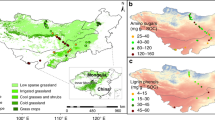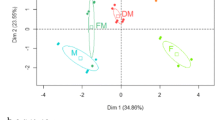Abstract
Grassland conversion is a common practice in ley-arable cropping systems. The effects of such a disturbance on soil organic matter status and its consequences for biogeochemical cycles in terms of soil organic matter (SOM) dynamics remain poorly understood. We investigated changes occurring in soil organic carbon and nitrogen content, bulk chemical composition and in lignin as well as carbohydrate signature during 2 years after grassland conversion into arable land. Our results showed a rapid SOM decrease in the first few months after the conversion. The bulk chemical composition as seen by solid-state 13C NMR spectroscopy was similar under grassland and arable land, whereas different landuse had an impact on the contribution of plant litter compounds to SOM. SOM of arable soil had higher lignin contents and lower contents of non-cellulosic neutral carbohydrates than grassland soil. After grassland conversion, the most prominent change was an increase of the SOM’s content of non-cellulosic carbohydrate above the contents recorded for grassland or arable land. Principal component analysis indicated that SOM chemical characteristics of converted grassland even after 2 years are similar to those of initial grassland. We conclude that the chemical composition of SOM is less susceptible to rapid change and that re-installation of grassland within some years will safeguard the initial SOM status in ley-arable rotations.






Similar content being viewed by others
References
Bahri H, Dignac M-F, Rumpel C, Rasse DP, Chenu C, Mariotti A (2006) Lignin turnover kinetics in agricultural soils is monomer specific. Soil Biol Biochem 38:1977–1988
Benner R, Fogel ML, Sprague EK, Hodson RE (1987) Depletion of 13C in lignin and its implications for stable carbon isotope studies. Nature 329:708–710
Besnard E, Chenu C, Balesdent J, Puget P, Arrouays D (1996) Fate of particulate organic matter in soil aggregates during cultivation. Eur J Soil Sci 47:495–503
Black GE, Fox A (1996) Recent progress in the analysis of sugar monomers from complex matrices using chromatography in conjunction with mass spectrometry or stand-alone tandem mass spectrometry. J Chromatogr A 720:51–60
Bruce JP, Langdale GW, West LT, Miller WP (1995) Surface soil degradation and soil productivity restoration and maintenance. Soil Sci Soc Am J 54:1744–1777
Bruce JP, Frome M, Haites E et al (1999) Carbon sequestration in soils. J Soil Water Conserv 54:382–386
Chabbi A, Rumpel C, Kögel-Knabner I (2007) Stable carbon isotope signature and chemical composition of organic matter of lignite containing mine soils and sediments are closely linked. Org Geochem 38:835–844
Dignac M-F, Rumpel C (2006) Relative distribution of hydroxyalkanoic acids and phenol mono- and dimers as plant molecular markers of aliphatic and aromatic constituents of aboveground maize tissues and of a cultivated soil. Org Geochem 37:1634–1638
Ehleringer JR, Buchmann N, Flanagan LB (2000) Carbon isotope ratios in belowground carbon cycle processes. Ecol Appl 10:412–422
Eusterhues K, Rumpel C, Kögel-Knabner I (2007) Composition and radiocarbon age of HF-resistant soil organic matter in a Podzol and a Cambisol. Org Geochem 38:1356–1372
Fengel D, Wegener G (1979) Hydrolysis of polysaccharides with trifluoroacetic acid and its application to rapid wood and pulp analysis. In: Brown RD, Jurasek L (eds) Hydrolysis of cellulose: mechanisms of enzymatic and acid catalysis. Advances in chemistry series 181. American Chemical Society, Washington, pp 146–158
Golchin A, Clarke P, Oades JM (1996) The heterogeneous nature of microbial products as shown by solid-state 13C CP/MAS NMR spectroscopy. Biogeochemistry 24:71–94
Guggenberger G, Christensen BT, Zech W (1994) Land-use effects on the composition of organic matter in particle-size separates of soil: I. Lignin and carbohydrate signature. Eur J Soil Sci 45:449--458
Guo LB, Gifford RM (2002) Soil carbon stocks and land use change: a meta analysis. Glob Chang Biol 8:345–360
Hedges JI, Ertel JR (1982) Characterization of lignin by capillary gas chromatography of cupric oxide oxidation products. Anal Chem 54:174–178
Hedges JI, Blanchette A, Weliky K, Devol AH (1988) Effect of fungal degradation on the CuO oxidation of lignin: a controlled laboratory study. Geochim Cosmochim Acta 52:2717–2726
Houghton RA (1999) The annual net flux of carbon to the atmosphere from changes in land use 1850–1990. Tellus 51B:298–313
Janzen HH, Campbell CA, Izaurralde RC, Ellert BH, Juma N, McGill AB, Yentner RP (1998) Management effects on soil C storage on the Canadian prairies. Soil Tillage Res 47:181–195
Kiem R, Kogel-Knabner I (2003) Contribution of lignin and polysaccharides to the refractory carbon pool in C-depleted arable soils. Soil Biol Biochem 35:101–118
Knicker H (1993) Quantitative 15 N- und 13C-CPMAS-Festkörper- und 15 N-Flüssigkeits-NMR Spektroskopie an Pflanzenkomposten und natürlichen Böden. Dissertation
Knicker H, Lüdemann HK (1995) N-15 and C13 CPMAS and solution NMR studies of N-15 enriched plant material during 600 days of microbial degradation. Org Geochem 23:329–341
Kögel I, Bochter R (1985) Characterization of lignin in forest humus layers by high-performance liquid chromatography of cupric oxide oxidation products. Soil Biol Biochem 17:637–640
Kögel-Knabner I (1997) 13C and 15 N NMR spectroscopy as a tool in soil organic matter studies. Geoderma 80:243–270
Lal R (2003) Global potential of soil C sequestration to mitigate the greenhouse effect. Crit Rev Plant Sci 22:151–184
Leifeld J, Kögel-Knabner I (2005) Soil organic matter fractions as early indicators for carbon stock ghanges under different land-use ? Geoderma 124:143–155
Marschner B, Brodowski X, Dreves A, Gleixner G, Gude A, Grootes PM, Hamer U, Heim A, Jandl G, Ji R, Kaiser K, Kalbitz K, Kramer C, Leinweber P, Rethemeyer J, Schäffer A, Schmidt MWI, Schwark L, Wiesenberg GLB (2008) How relevant is recalcitrance for the stabilization of organic matter in soils? J Plant Nutr Soil Sci 171:91--132
Martens DA, Reedy TE, Lewis DT (2003) Soil organic carbon content and composition of 130-year crop, pasture and forest land-use managements. Glob Chang Biol 10:65–73
Mueller CW, Kögel-Knabner I (2009) Soil organic carbon stocks, distribution, and composition affected by historic land use changes on adjacent sites. Biol Fertil Soils 45:347–359
Murayama S (1984) Changes in the monosaccharide composition during the decomposition of straws under field conditions. Soil Sci Plant Nutr 30:367–381
Nevens F, Reheul D (2003) Permanent grassland and 3-years leys alternating with 3 years of arable land: 31 years of comparison. Eur J Agron 19:77–90
Nierop KGJ, Pulleman MM, Marinissen JCY (2001) Management induced organic matter differentiation in grassland and arable soil: a study using pyrolysis techniques. Soil Biol Biochem 33:755–764
Oades JM (1984) Soil organic matter and structural stability: mechanisms and implications for management. Plant Soil 76:319–337
Post WM, Kwon KC (2000) Soil carbon sequestration and land-use change: processes and potential. Glob Chang Biol 6:317–327
Reicosky DC, Kemper WD, Landale GW, Douglas CL, Rasmussen PE (1995) Soil organic matter changes resulting from tillage and biomass production. J Soil Water Conserv 50:253–261
Rumpel C, Dignac M-F (2006) Gas chromatographic analysis of non-cellulosic neutral polysaccharides in a forest soil profile: analysis by gas chromatography after trifluoroacetic acid hydrolysis and reduction-acetylation. Soil Biol Biochem 38:1478–1481
Rumpel C, Kögel-Knabner I (2002) The role of lignite in the carbon cycle of lignite-containing mine soils: evidence from carbon mineralisation and humic acid extractions. Org Geochem 33:393–399
Rumpel C, Eusterhues K, Kögel-Knabner I (2004) Location and chemical composition of stabilized organic carbon in topsoil and subsoil horizons of two acid forest soils. Soil Biol Biochem 36:177–190
Rumpel C, Rabia N, Derenne S, Quenea K, Eusterhues K, Kögel-Knabner I, Mariotti A (2006) Alterations of soil organic matter following treatment with hydrofluoric acid (HF). Org Geochem 37:1437–1451
Rumpel C, Chabbi A, Nunan N, Dignac M-F (2009) Impact of landuse change on the molecular composition of soil organic matter. J Anal Appl Pyrol 85:431–434
Rumpel C, Eusterhues K, Kögel-Knabner I (2010) Non-cellulosic neutral sugar contribution to mineral associated organic matter in top-and subsoil horizons of two acid forest soils. Soil Biol Biochem. doi:10.1016/j.soilbio.2009.11.004
Schaefer J, Stejskal EO (1976) Carbon-13 nuclear magnetic resonance of polymers spinning at magic angle. J Am Chem Soc 98:1031–1032
Six J, Elliott ET, Paustian K, Doran JW (1998) Aggregation and soil organic matter accumulation in cultivated and native grassland soils. Soil Sci Soc Am J 62:1367–1377
Spielvogel S, Prietzel J, Kögel-Knabner I (2008) Soil organic matter stabilization in acidic forest soils is preferential and soil type-specific. Eur J Soil Sci 59:674–692
Steenwerth KL, Jackson LE, Cakderon FJ, Stromberg MR, Scow KM (2002) Soil microbial community compos0069tion and land-use change history in cultivated and grassland ecosystems of coastal California. Soil Biol Biochem 34:1599–1611
Stemmer M, vonLützow M, Kandeler E, Pichlmayer F, Gerzabek MH (1999) The effect of maize straw placement on mineralisation of C and N in soil particle size fractions. Eur J Soil Sci 50:73–85
Thévenot M, Dignac M.-F, Rumpel C (submitted) Fate of lignins in soils: a review. Soil Biol Biochem
Van Eederen N, Bommelé L, Bloem J, Schouten T, Rutgers M, de Goede R, Reheul D, Brussaard L (2008) Soil biological quality after 36 years of ley-arable cropping permanent arable cropping. Appl Soil Ecol 40:432–446
Wilson MA (1987) NMR-techniques and application in geochemistry and soil chemistry. Pergamin Press, Oxford
Acknowledgments
We acknowledge the financial support of the French ministry of ecology, energy, sustainable development and land management for financial support under the framework of the GESSOL program ‘COSMOFLUX’. Gérard Bardoux and Xavier Charrier are acknowledged for technical support
Author information
Authors and Affiliations
Corresponding author
Rights and permissions
About this article
Cite this article
Rumpel, C., Chabbi, A. Response of bulk chemical composition, lignin and carbohydrate signature to grassland conversion in a ley-arable cropping system. Nutr Cycl Agroecosyst 88, 173–182 (2010). https://doi.org/10.1007/s10705-009-9333-0
Received:
Accepted:
Published:
Issue Date:
DOI: https://doi.org/10.1007/s10705-009-9333-0




